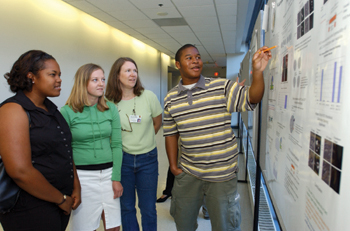
From left, students Kamilah Carter and Erikah Takle and Ruth Ann Veach, a research assistant in Microbiology and Immunology, listen to Richard Green discuss his poster on regulation of organelle pH during the closing symposium of the Vanderbilt Summer Science Academy. Green worked in the lab of Todd Graham, Ph.D. Eighty undergraduate and graduate students came to Vanderbilt this summer. Photo by Anne Rayner
Budding scientists spend summer learning the ins and outs of a career in research
On Aug. 6, the Vanderbilt University School of Medicine Summer Science Academy Research Symposium gave about 60 students an opportunity to present their research by giving oral or poster presentations.
The symposium is the finale to a summer-long program — Vanderbilt’s Summer Science Academy (SSA), directed by Michelle Grundy, Ph.D. —where about 70 to 80 mostly undergraduate students come to Vanderbilt to participate in internships in science.
These internships, which students must apply for, include learning not only in research labs, but also listening each week to different enrichment talks that may include how to read the scientific literature, learning information on how to get ready for the Graduate Record Examination (GRE), or preparing for graduate school.
“Obviously, a major part of science, after doing the science, is presenting the science. And so we have a symposium at the end of the summer, and we try and make it seem a little bit like the real thing — so the students make posters and they give formal presentations. And all the students from all the programs will be giving talks or presenting posters,” said Roger Chalkley, D. Phil, senior associate dean of Biomedical Research Education and Training.
These programs were created after the mid-1990s, when several faculty members began to receive some support primarily from the NIH for research exposure to under-represented minorities. From there, they started the SSA two years ago.
“We had 10 or so different programs of one sort or another, each offering more or less the same enrichment activities. So it made sense to set up an umbrella program to hopefully make things more efficient,” said Chalkley.
One of the programs is the Bridges program, coordinated by Cathleen C. Williams and run by Louis J. DeFelice, Ph.D.
The NIH-supported Bridges program students are the exception in the SSA, in that they are, for the most part, in master’s programs.
“[The Bridges program] identifies students who are in master’s programs at minority-serving institutions and then they bring them into the Vanderbilt orbit, where we help with career development each summer,” said Chalkley.
This year’s SSA Research Symposium was a great success. After an introduction by Grundy, the oral presentations ensued, proving the value of perseverance and superb organization.
One of the students who gave a presentation was Jillian Pope, in her first year at Florida Agricultural and Mechanical University (Florida A & M University) in the master’s program. Pope, who presented her research on “The Quest for an Inhibitor of Botulinum Neurotoxin Serotype C Protease” is pleased with her experience at Vanderbilt.
“The best part of the experience was actually working in the laboratory — getting to know the ins and outs of research — and actually performing the procedures, working with the professors and learning about different programs like GRE sessions. In addition, certain professors came and talked to us about their research — it really opened doors for us,” she said.
After the oral presentations, SSA poster presentations began. The poster presentations gave the students in all the programs a chance to show their summer of hard work at Vanderbilt. Like the oral presentations, the posters showed great effort.
One of the students who presented a poster was Brooke Richardson, an undergraduate student at Transylvania University, where she is a junior. Richardson presented a poster about her research on “Studies on a Fosfomycin Resistance Protein from B. subtilis.”
“Seeing the lab atmosphere and being able to participate in research and learning the techniques has been great. I definitely enjoyed it — this experience confirmed that I do want to go to grad school and do research,” she said.
This kind of confirmation in Richardson’s mind about going to graduate school is one of the SSA’s main goals — to spark interest in Vanderbilt’s graduate school, as a way to recruit students into graduate programs.
The number of summer students who actually end up in graduate school at Vanderbilt is between five to 10 students.
“If we were to get six or seven students to develop a long-term interest in doing graduate research here, then that would be really good for the diversity activities of the institution,” said Chalkley.













